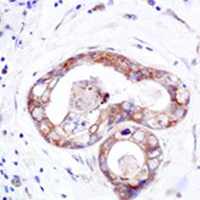Expressions of ZNF436, β-catenin, EGFR, and CMTM5 in breast cancer and their clinical significances

Submitted: 13 August 2020
Accepted: 7 December 2020
Published: 20 January 2021
Accepted: 7 December 2020
Abstract Views: 1463
PDF: 599
Supplementary: 131
HTML: 11
Supplementary: 131
HTML: 11
Publisher's note
All claims expressed in this article are solely those of the authors and do not necessarily represent those of their affiliated organizations, or those of the publisher, the editors and the reviewers. Any product that may be evaluated in this article or claim that may be made by its manufacturer is not guaranteed or endorsed by the publisher.
All claims expressed in this article are solely those of the authors and do not necessarily represent those of their affiliated organizations, or those of the publisher, the editors and the reviewers. Any product that may be evaluated in this article or claim that may be made by its manufacturer is not guaranteed or endorsed by the publisher.
Similar Articles
- Lucia Aidos, Luisa M. Pinheiro Valente, Vera Sousa, Marco Lanfranchi, Cinzia Domeneghini, Alessia Di Giancamillo, Effects of different rearing temperatures on muscle development and stress response in the early larval stages of Acipenser baerii , European Journal of Histochemistry: Vol. 61 No. 4 (2017)
- Anett Kristin Larsen, Jaione Simón-Santamaría, Kjetil Elvevold, Bo Göran Ericzon, Kim Erlend Mortensen, Peter McCourt, Bård Smedsrød, Karen Kristine Sørensen, Autofluorescence in freshly isolated adult human liver sinusoidal cells , European Journal of Histochemistry: Vol. 65 No. 4 (2021)
- Eetmad A. Arafat, Eman M.I. Youssef, Hanaa A. Khalaf, The possible alleviating effect of garlic supplement on the neural retina in a rat model of hypercholesterolemia: a histological and immunohistochemical study , European Journal of Histochemistry: Vol. 65 No. 4 (2021)
- Li Niu, Xiaoying Chu, Yaofei Jiang, Wei Zeng, HPV infection upregulates the expression of ZNT-1 in condyloma acuminatum , European Journal of Histochemistry: Vol. 65 No. 2 (2021)
- Giuliano Mazzini, The Feulgen reaction: from pink-magenta to rainbow fluorescent at the Maffo Vialli’s School of Histochemistry , European Journal of Histochemistry: Vol. 68 No. 1 (2024): 1954-2024: 70 Years of Histochemical Research
- Yankun Wang, Yuning Liu, Yawei Wang, Ao Zhang, Wenqian Xie, Haolin Zhang, Qiang Weng, Meiyu Xu, Investigation of seasonal changes in lipid synthesis and metabolism-related genes in the oviduct of Chinese brown frog (Rana dybowskii) , European Journal of Histochemistry: Vol. 67 No. 4 (2023)
- G. Latella, A. Vetuschi, R. Sferra, S. Speca, E. Gaudio, Localization of avβ6 integrin- TGF-β1/Smad3, mTOR and PPARgg in experimental colorectal fibrosis , European Journal of Histochemistry: Vol. 57 No. 4 (2013)
- J. Rieger, S. Twardziok, H. Huenigen, R. M. Hirschberg, J. Plendl, Porcine intestinal mast cells. Evaluation of different fixatives for histochemical staining techniques considering tissue shrinkage , European Journal of Histochemistry: Vol. 57 No. 3 (2013)
- Karel Smetana, Dana Mikulenková, Josef Karban, Marek Trněný, To the ring-shaped nucleolus seen by microscopy using human lymphocytes of blood donors and chronic lymphocytic leukemia patients , European Journal of Histochemistry: Vol. 68 No. 3 (2024)
- Francesca Diomede, Soundara Rajan Thangavelu, Ilaria Merciaro, Monica D'Orazio, Placido Bramanti, Emanuela Mazzon, Oriana Trubiani, Porphyromonas gingivalis lipopolysaccharide stimulation in human periodontal ligament stem cells: role of epigenetic modifications to the inflammation , European Journal of Histochemistry: Vol. 61 No. 3 (2017)
<< < 30 31 32 33 34 35 36 37 38 39 > >>
You may also start an advanced similarity search for this article.

 https://doi.org/10.4081/ejh.2021.3173
https://doi.org/10.4081/ejh.2021.3173










